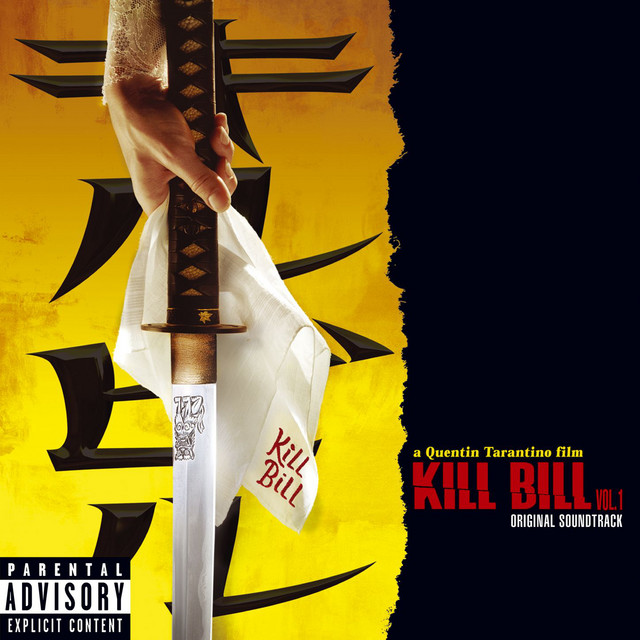Film soundtracks can often seem arbitrary, merely used as a way to transition between scenes, promote specific artists, or fill the silence. But when used with intention, music can function as a beautiful part of the story; setting the tone, narrating the plot, and breathing new life into the scripts. Renowned actor and filmmaker Quentin Tarantino knows exactly how to achieve this, in his classic revenge thrillers, Kill Bill: Volume 1 (2003) and Kill Bill: Volume 2 (2004). Both movies utilize their scores in slightly different ways, but are still connected to one another. The first installment adopts a more in-your-face approach, as many of the songs aid the warfare and almost takes on a secondary role as storyteller. The sequel however, is far more subtle, and serves primarily to flow with the sequence of events and shift the mood as needed.
Following the grim introductory scene, which is a disturbing black and white shot of The Bride lying in a pool of blood and betrayal, is the soft and ghostly voice of Nancy Sinatra. Her version of Cher’s folk-rock hit “My Baby Shot Me Down” describes The Bride’s peril perfectly. Ominous lyrics serenade us — “Bang Bang / That Awful Sound / Bang Bang / My Baby Shot Me Down” — accompanied only by tremolo guitars; it has an almost theatrical undertone. Soon after, the film cuts to a drastically different atmosphere. In place of what was a gory tragedy, is now a suburban home with vibrant greenery and children’s toys scattered across the lawn. Nancy’s vocals beautifully embellish the jarring tonal difference between the two settings.
Music creates a layer of depth beyond cinematography. Something that’s extremely prevalent upon meeting one of the many antagonists, Elle Driver. We see her walking down a dimly-lit hospital corridor whistling “Twisted Nerve,” an eerie tune by Bernard Hermann. As she preps for what we’ll quickly discover are malicious intentions, a hair-raising series of glissando strings and a chilling synth build in intensity — making it abundantly clear that Elle is not a friend. It’s a clever insertion, as one could argue the general ambiance of hospitals are creepy enough (especially at night), but to add a lone whistle echoing throughout the halls is an even more unsettling experience.
Parts of the soundtrack stood out more than others, including Santa Esmerelda’s cover of “Don’t Let Me Be Misunderstood” during the battle against O-Ren Ishii. It’s a funky, latin disco version of the bluesy original by Nina Simone.
When I first watched this scene, I remember thinking how out of place this song felt. O-Ren’s first step toward her opponent elicits a sudden onset of the song, and when she lands her first strike (slashing The Bride’s back), the song instantly stops. It’s almost as if the music was moving with O-Ren, because so far this is the first fight where the protagonist’s adversary has the upper hand.
At this point, her previous encounters have exhausted her, and O-Ren knows this. But as she regains her fortitude, we no longer hear Esmerelda. In fact, it’s silent until the fatal blow to O-Ren’s skull, prompting Meiko Kaji’s “The Flower of Carnage” to play like a celebratory anthem. It’s a slow, jazzy lullaby with lyrics that talk about a woman whose sympathy has run dry, and has instead been replaced with an all encompassing resentment. How fitting! Now I understand why “Don’t Let Me Be Misunderstood” felt so misplaced, because as the audience we are not meant to root for O-Ren, yet the music seemed to initially follow her lead. Yet another example of how the score captivates us in thought-provoking ways!
Both soundtracks feature many small notable moments, such as The 5. 6. 7. 8’s lively performance of “Woo Hoo” during a comical montage. The cheerful repetition and brisk drum pattern offers a nice change of pace from the otherwise serious theme of revenge. Also Ennio Morricone’s orchestral “L’Arena,” bringing forth a feeling of triumph as The Bride claws her way to the surface after being buried alive.
However, there is one sound that remains consistent throughout the entire duology, and I can’t neglect to mention: “Ironside” by Quincy Jones. The infamous siren plays whenever The Bride lays eyes on those who have wronged her. Paired with a dramatic zoom-in and a fatal glare, this quickly becomes a sign of imminent bloodshed. If this is your first introduction to this song, you’d never guess just how jazzy and upbeat the composition actually is! Here, it’s used to strike a chord of familiarity associated with each of her violent conquests, leading up to the one person we’ve all been waiting to see: Bill. Cleverly setting the audience up for the unexpected, there are no sirens when they come face-to-face. For a moment, her rampaging tunnel vision comes to a screeching halt at the sight of her daughter. The noticeable silence speaks volumes, and in contrast to her previous encounters, we’re left wondering what will happen next.
Advertisement
The Kill Bill franchise is revered by many for Uma Thurman’s stunning performance as the vindictive assassin, among a memorable cast of rivals with entangled pasts. But beyond all of the chaos, their scores draw the audience deeper into the story, effectively pulling our ears and instilling a great appreciation for Tarantino’s worldbuilding.
Advertisement
